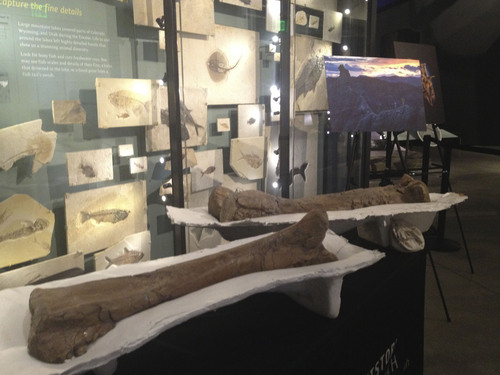This is an archived article that was published on sltrib.com in 2014, and information in the article may be outdated. It is provided only for personal research purposes and may not be reprinted.
Most everyone is familiar with Utah's Life Elevated campaign, but perhaps it is time for a change.
How about Laramidia Life Elevated?
That was the suggestion from Vicki Varela, managing director of the Utah Office of Tourism, during a news conference Thursday at the Natural History Museum of Utah.
Museum and state tourism officials gathered to celebrate a 20-page story, heavy on pictures and graphics, titled "Digging Utah's Dinosaurs" in the May 2014 issue of National Geographic.
"Laramidia is what this region was known as when it was a tropical destination for dinosaurs," Varela said. The state is lucky to have National Geographic highlight one of the largest and best collections of prehistoric animals on the face of the earth, she said. "The world knows about our Mighty 5 national parks and now this is calling attention to the fact that this is the place to come to discover dinosaurs."
A magazine reporter and photographer joined paleontologists from the Natural History Museum of Utah and the Denver Museum of Nature & Science on the Grand Staircase-Escalante National Monument in 2013.
"We as a museum, as a university and a state have known about how special our dinosaurs are, particularly all these dinosaurs we are finding in the Grand Staircase," said Randall Irmis, curator of paleontology at the museum on Salt Lake City's east side. "But this story gives us a chance to boast to the rest of the world the amazing dinosaurs and the ancient life that we have in the state."
A National Geographic Society grant paid for a helicopter to transport the research team into a remote camp where they worked for several weeks. The chopper also carried fossils out of the dig area, one of the most remote in the lower 48 states, Irmis said.
"They helicoptered literally thousands of pounds of dinosaur fossils," Irmis said. "We had one plaster jacket fossil that was 2,200 pounds alone."
Sarah George, director of the Natural History Museum of Utah, said research in the Grand Staircase has been underway for years. "It is one of the last unexplored regions for fossil records, especially for dinosaurs in North America," she said.
The 2 million acres of the national monument are important because they hold species from a "poorly documented" timeframe in the late Cretaceous period about 75 to 80 million years ago, George said.
The Office of Tourism is taking advantage of attention from the national magazine and has posted dinosaur-related information at the VisitUtah.com website, under the Dinosaurs & Paleontology tab.
"We have a fresh new list of all the different ways people can experience dinosaurs in Utah," Varela said.
Twitter: @BrettPrettyman





